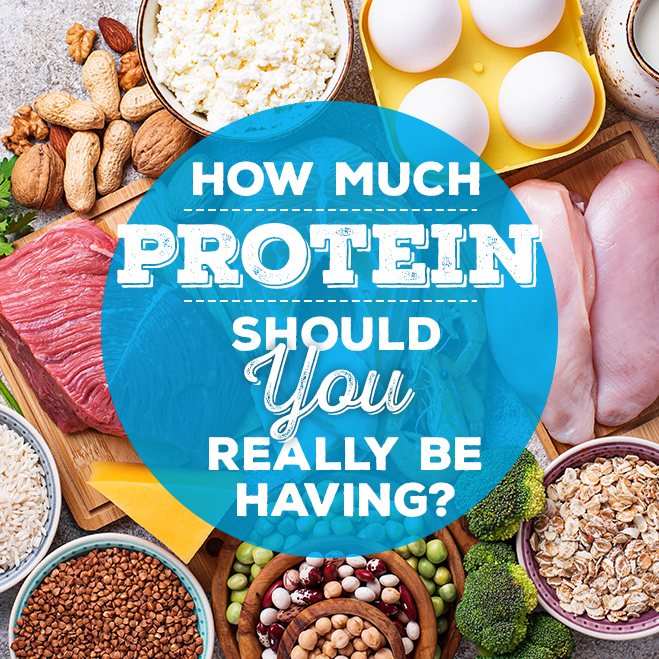 There are many misnomers and confusion surrounding the macronutrient, protein. We have all heard we need it, but what does it do exactly? What foods is it in? And how much should we be having based on the exercise we do? Let’s break it down.
There are many misnomers and confusion surrounding the macronutrient, protein. We have all heard we need it, but what does it do exactly? What foods is it in? And how much should we be having based on the exercise we do? Let’s break it down.
Started from the bottom now we’re here – “Amino Acids”
Amino acids are the most basic form of protein, the building blocks. In total, there are 20 different amino acids – 9 of which the body cannot produce on its own and therefore, needs from the food we consume. These important 9 are called essential amino acids. A ‘complete protein’ is a structure that contains all 9 of the essential amino acids, and an ‘incomplete protein’ is one lacking at least 1 or more of these 9 essentials.
In our bodies, protein is first broken down into amino acids before it is then reconstructed into more useful chains and sequences for the body to use. Protein in our bodies is used for:
- Cellular repair and recovery,
- Building muscle and to help us grow, and
- Making hormones and it helps to protect the body from viruses and bacteria.
Wait.. there are different types of protein?
It is important to know that not all proteins are made the same. As mentioned above they can differ in their amino acid structure and composition. Animal-based and soy isolate proteins have a relatively high amino acid makeup compared to plant-based proteins. High biological value protein foods (containing ‘complete proteins’, meaning they contain all 9 essential amino acids) appear to be quite beneficial.
Proteins also differ from their rate of digestion in the body. The digestion rate of acid-soluble proteins such as whey and soy are more rapid than casein protein. Proteins that contain high amounts of amino acids and are more rapidly digested can stimulate a more rapid rise in muscle protein synthesis after exercise; meaning the body more readily absorbs and utilises it for its muscles.
Animal-based protein sources include lean meats, poultry, eggs, fish and dairy products. Plant-based protein sources include rice, legumes, lentils, tofu and tempeh.
But isn’t there a thing as too much protein?
The kidneys are a filtrating organ, meaning they help to remove excess nutrients (including amino acids), electrolytes and minerals out of our bodies via our urine. There is a common misconception that high protein diets can pose a significant health risk to those who consume more than the average recommendation. This is because it is universally thought that too much protein consumed in the diet is associated with straining the kidneys (think: too much at once).
However, research has shown that healthy individuals with uncompromised renal function show no link between protein intake and renal damage1. That being said, clinical populations who do have compromised renal function would indeed benefit from lower protein diets.
Nevertheless, a high protein intake is of disadvantage when you start to sacrifice other important nutrients (equally necessary for normal body functions and key for both performance and training) for the sake of a high protein diet. *Ahem*… carbohydrates… fats…
Timing, is it everything?
Current evidence suggests that consuming a source of protein as soon as possible after exercise enhances muscle uptake, protein balance and amino acid retention – leading to a quicker response in muscle remodelling2. However, due to the body’s sensitive state post-exercise, protein consumed even up to 24 hours post-activity would similarly contribute to this remodelling of muscle, rather than thinking of a limited 30-60 minute “window of opportunity” post-activity. This means that while the immediate post-exercise period is the best time to consume a source of protein, the 24-48 hour period post-exercise also enhances the body’s uptake and use of protein3-5.
In order to support the greatest rates of muscle remodelling, it is recommended to consume protein soon after exercise and every 3-4 hours thereafter. Furthermore, research shows that if you have consumed protein pre-workout, then the need for a protein source ASAP post-exercise is reduced, opposed to working out completely fasted6.
But how much do I need!? (emphasis on the “I”)
According to evidence, the recommended amount of protein the average healthy, untrained person needs is 0.8 – 1 grams (g) of protein per kilogram (kg) of body weight each day (0.8-1g/kg/bw/day)7. This is a recommended minimum amount to prevent protein deficiency.
As an example, “Person X” weighs 75kg. They may not exercise at all, may only do incidental activities or go light walking every day. As a minimum they would need 60-75g protein per day to prevent protein deficiency and keep their normal bodily functions working optimally.
This is usually achievable if you are consuming some source of protein at each meal and/or snack. For example, cereal with 1 cup of milk for breakfast, a can of tuna and salad for lunch, 200g yoghurt as a snack and 100g chicken breast with vegetables provides approximately 65g protein.
However, when we exercise our bodies require even more protein than this above basic recommendation. If you are active, you will need additional protein to optimise your recovery. Evidence shows that for those who are training, it would be more optimal to reach for a daily protein goal of 1.2 – 1.7 grams of protein per kilogram of body weight every day (1.2-1.7g/kg/bw/day)8.
This range would be suitable to those who exercise several times a week (whether that be from HIIT training, going to the gym or running), are playing endurance sports or recreationally lifting.
For example, “Person X” is now going to the gym several times a week. Now their optimal protein requirements would increase to a range of 90-128g protein per day.
Protein requirements will be highest for those looking to build muscle up, which is looking more like a protein goal of 1.6 – 2.2 grams protein per kilogram of body weight daily (1.6-2.2g/kg/bw/day)9.
For example, “Person X” at 75kg should aim for 120-165g protein per day when in a muscle building routine.
More extreme protein intakes than these recommendations will not likely be necessary nor is currently proven to be more beneficial; we will likely excrete it or use it for energy. Additionally, it is important to note that if you are looking to build muscle, you will need to be in a positive energy balance (calorie surplus).
Conversely, while resistance training helps to maintain muscle mass whilst in calorie deficit, it is important to pair this with adequate protein intake. This is where post-exercise protein ingestion is essential to enhance muscle protein synthesis, and research shows that approximately 1.6g protein/kg of body weight may support a greater retention of lean mass10,11.
My takeaways –
- Consume sufficient protein for your requirements. Thinking ahead about daily protein sources could be useful.
- It is ideal to distribute your protein intake over 3-6 meals across the day; through even spreads of protein you will more likely reach your daily targets. Aim to consume 20-40g of protein (depending on your requirements) every 3-4 hours.
- Consume a decent amount of protein somewhere close to the time that you work out/exercise (within a few hours).
- Try opting for a source of protein in your snacks for morning and afternoon tea.
- More is not always better. Our bodies cannot consume copious amounts of protein all at once, and excess will likely be excreted through your urine.
- Focus on getting protein from a variety of different sources – both animal and plant-based.
- If you need help, ask a professional! If you’re still unsure about how much protein you should be having, or looking for more tips on increasing protein intake, book in an appointment with me and we will tailor a plan for your own individualised needs.
Isabelle Jardine APD
References
1Martin WF, Armstong LE, Rodriguez NR. Dietary protein intake and renal function. Nutr Metab (Lond) 2005; 2:25.
2Burd NA, Tang JE, Moore DR, Phillips SM. Exercise training and protein metabolism: influences of contraction, protein intake, and sex-based differences. J Appl Physiol 2009; 106:1692-701.
3Phillips SM, Tipton KD, Aarsland A, Wolf SE, Wolfe RR. Mixed muscle protein synthesis and breakdown after resistance exercise in humans. AM J Physiol 1997; 273:E99-107.
4Kim PL, Staron RS, Phillips SM. Fasted-state skeletal muscle protein synthesis after resistance exercise is altered with training. J Physiol 2005;568:283-90.
5Miller BF, Olesen JL, Hansen M et al. Coordinated collagen and muscle protein synthesis in huma patella tendon and quadriceps muscle after exercise. J Physiol 2005;567:1021-33.
6Schoenfeld BJ, Aragon AA, Krieger JW. The effect of protein timing on muscle strength and hypertrophy: a meta-analysis. J Int Soc Sports Nutr 2013;10:53.
7Food and Nutrition Board, Institute of Medicine. Dietary references intakes for energy, carbohydrate, fibre, fat, fatty acids, cholesterol, protein, and amino acids. Washington DC: National Academies Press, 2002.
8Phillips SM, van Loon LJ. Dietary protein for athletes: From requirements to optimum adaptation. J Sports Sci 2011;29(1 Suppl):29S-38S.
9 Schoenfeld BJ & Aragon AA. How much protein can the body use ina single meal for muscle-building? Implications for daily protein distribution. J Int Soc Sports Nutr 2018;15:10.
10 Mettler S, Mitchell N, Tipton KD. Increased protein intake reduces lean body mass loss during weight loss in athletes. Med Sci Sports Exerc 2010;278:E580-7.
11Pasiakos SM, Cao JJ, Margolis LM, et al. Effects of high-protein diet on fat-free mass and muscle protein synthesis following weight loss: a randomised controlled trial. FASEB J 2013; 27:3837-47.
Burke, L & Deakin, V 2015. Clinical Sports Nutrition (5th Ed). McGraw-Hill, Sydney Australia.
Stewart, R 2015. Handbook of Clinical Nutrition and Dietetics (5th Ed, revised). Australian Dietitian, Brisbane Australia.
